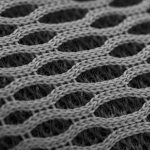When you're looking to give your fabric the right amount of stiffness, it's essential to know your options. You've got liquid starch, spray stiffeners, and fusible interfacing, each with its unique benefits. Liquid starch is great for versatility, while spray options offer convenience, and fusible interfacing delivers a more permanent solution. But what about homemade recipes that can tailor the stiffness to your specific needs? Exploring these alternatives might just lead you to the perfect solution for your next project.
Table of Contents
Key Takeaways
- Liquid starch is versatile and suitable for a variety of home sewing projects, enhancing fabric stiffness effectively.
- Spray-on stiffeners offer quick and convenient application, perfect for on-the-go fabric adjustments without mixing.
- Fabric gels provide an intense hold for heavier fabrics, ideal for projects requiring significant structure.
- Fusible interfacing bonds with heat, available in various weights, making it perfect for collars and cuffs.
Overview of Stiffening Agents
When you want to add structure to your fabric projects, stiffening agents can make all the difference. These products enhance the body and durability of your textiles, allowing you to create everything from crisp collars to structured crafts. Stiffening agents come in various forms, each with unique properties suited for specific applications.
You'll find options like liquid starch, spray-on stiffeners, and even fabric gels. Liquid starch is versatile and often used in home sewing projects, while spray-on stiffeners are great for quick fixes and can be easily applied. Fabric gels, on the other hand, offer a more intense hold and work well for heavier fabrics or intricate designs.
When selecting a stiffening agent, consider the type of fabric you're using and the desired stiffness level. Some agents work better on cotton, while others are ideal for synthetic blends. It's also important to think about how the final product will be used. If it's going to be washed frequently, you'll want a more durable option.
Starch-based Products
Starch-based products are popular choices for adding stiffness to fabrics, making them ideal for everything from crisp table linens to tailored garments. You can find these products in various forms, including liquid starch, powder starch, and even ready-to-use spray starch. Each option has its advantages, depending on your specific needs.
When using liquid starch, you'll typically dilute it with water before applying it to your fabric. This method allows for better control over the stiffness level, so you can create the perfect crispness for your project.
Powder starch, on the other hand, requires a bit more preparation, as you'll need to dissolve it in water before use. This can be a great option if you prefer a customizable solution.
For quick touch-ups, ready-to-use starch sprays are incredibly convenient. Just spray it on your fabric and iron for instant stiffness. However, keep in mind that these products can vary in strength, so it's wise to test a small area first.
Spray Stiffeners
Spray stiffeners offer a quick and convenient way to achieve fabric rigidity without the hassle of mixing solutions. These products come in aerosol cans, allowing you to easily spray your fabric and achieve the desired stiffness. You'll find them ideal for various projects, like crafts, home decor, or even clothing.
To use spray stiffeners, simply hold the can about 6 to 12 inches away from the fabric. Spray in even strokes to ensure uniform coverage. It's essential to test the stiffener on a small piece of fabric first, as different materials may react differently. Once applied, let the fabric dry completely for the best results.
One of the biggest advantages of spray stiffeners is their versatility. You can adjust the stiffness by applying multiple coats, so you have complete control over the final texture. Plus, they're easy to store, making them a great addition to your crafting supplies.
Keep in mind that not all spray stiffeners are created equal. Some may leave a residue or make the fabric feel crunchy, so read reviews and choose a product that suits your project needs. With the right spray stiffener, you'll achieve the perfect balance of firmness and flexibility.
Fusible Interfacing
Fusible interfacing provides a reliable way to add structure and support to your fabric projects by bonding directly to the material with heat. This product typically comes in lightweight, medium, or heavy weights, allowing you to choose the right stiffness based on your project's needs. You'll find it available in various forms, including woven and non-woven types, giving you options for different fabrics.
To use fusible interfacing, start by cutting the interfacing to match your fabric pieces. Place the adhesive side against the wrong side of the fabric, then use an iron to activate the adhesive. Make sure to set the iron to the appropriate temperature for your fabric type and press firmly for a few seconds. Avoid sliding the iron, as this could shift the interfacing.
After fusing, you'll notice your fabric feels more stable and holds its shape better, making it ideal for collars, cuffs, and structured garments. Plus, fusible interfacing is perfect for home décor projects, like pillow covers or bags. With this easy application method, you can enhance your fabric's durability and appearance without hassle.
Homemade Fabric Stiffeners
Creating your own fabric stiffener at home is a simple and cost-effective way to achieve the desired firmness for your projects. You can use common household ingredients, allowing you to customize the stiffness based on your needs. Here are three popular homemade recipes:
| Ingredients | Instructions |
|---|---|
| 1 part white glue | Mix with 1 part water. Stir until smooth. Apply with a brush or spray. |
| 1 part cornstarch | Combine with 2 parts water. Heat gently until thickened. Cool before use. |
| 1 part vinegar | Mix with 1 part water. Shake well before applying. Best for lightweight fabrics. |
When using these recipes, keep in mind that the consistency can be adjusted. For a stiffer finish, increase the glue or cornstarch ratio. Remember to test on a small fabric piece first to ensure you like the results. Homemade stiffeners not only save you money but also allow you to create a tailored solution for each of your crafting projects. So, gather your materials and start experimenting!
Frequently Asked Questions
Can I Use Stiffeners on Delicate Fabrics Like Silk?
You can use stiffeners on delicate fabrics like silk, but be cautious. Test a small area first to avoid damage. Choose a gentle formula and follow the instructions to achieve the desired stiffness without harming the fabric.
How Long Does Fabric Stiffening Last After Application?
Fabric stiffening typically lasts anywhere from a few days to several weeks, depending on factors like the type of stiffener used and environmental conditions. You can refresh it as needed for ongoing support and structure.
Are There Any Non-Toxic Stiffening Options Available?
Yes, there are non-toxic stiffening options available. You can use homemade solutions like cornstarch or sugar water, or look for commercial products labeled as eco-friendly. These choices are safer for you and the environment.
Can I Wash Fabric After Applying Stiffeners?
Yes, you can wash fabric after applying stiffeners, but it's best to check the product instructions first. Some stiffeners might wash out, while others could hold up better. Always test on a small area first!
How Do I Remove Stiffening Products From Fabric?
To remove stiffening products from fabric, soak it in warm water mixed with mild detergent. Gently agitate the fabric, then rinse thoroughly. You might need to repeat this process for complete removal.
- What Is Pochampally Ikat? a Journey to India’s Silk City - June 27, 2025
- What Is Pochampally Ikat? a Journey to India’s Silk City - June 27, 2025
- What Is Pochampally Ikat? a Journey to India’s Silk City - June 27, 2025







